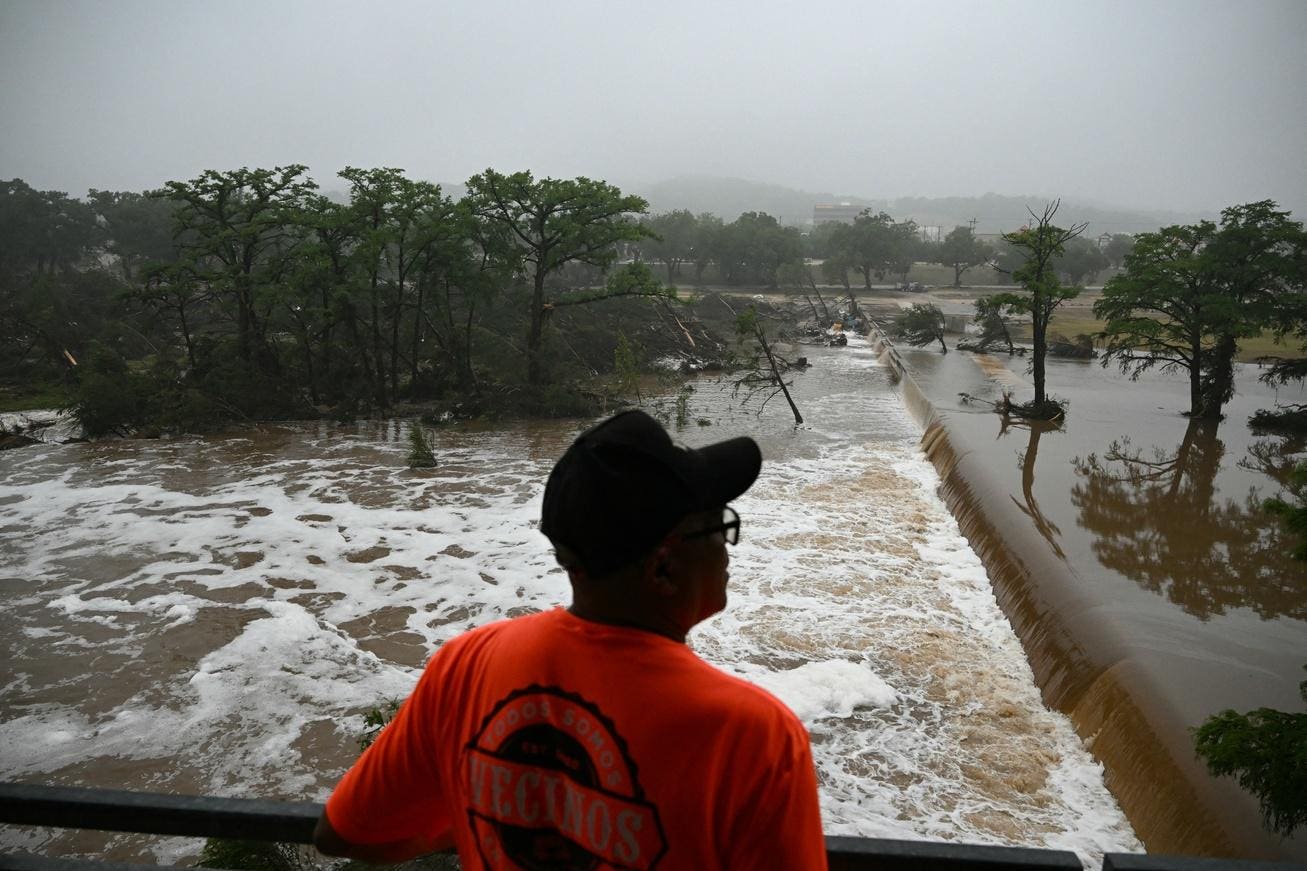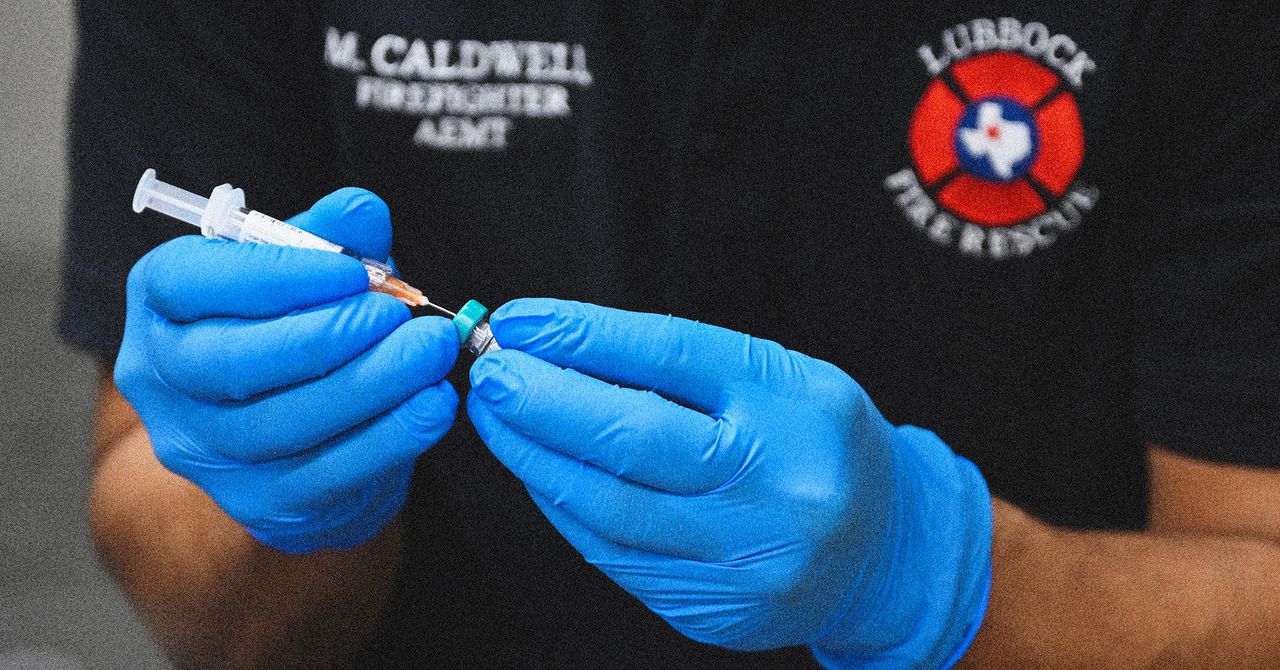A member of the public looks out at flooding caused by a flash flood at the Guadalupe River in … More
The catastrophic flooding in the hill country of Texas is the latest U.S. extreme weather event to cause significant disruption. At the time of writing, the death toll had surpassed 50, and many people are still missing. As this tragedy unfolds, every stone should be flipped to find ways to prevent such horrific loss of life. Some experts believe the Texas floods make the case for a weather radio renaissance.
The Last Mile
As I wrote in a companion piece this weekend, the National Weather Service issued guidance and warning information in the days to hours leading up to the massive flood event. However, questions exist about whether there were challenges getting the information across what my colleague Bob Henson calls the “last mile” to the public via emergency management and communication channels. By the way, Henson and his colleague Jeff Masters wrote a great analysis on this flood catastrophe.
Crews work to clear debris from the Cade Loop bridge along the Guadalupe River on Saturday, July 5, … More
Though weather forecasts were within expectations of sound verification, a couple of familiar challenges emerged. First, narratives that say the “bullseye” in rainfall was off by 20 miles so the forecast was wrong are flawed. Decisions should be made based on current capabilities. If it rains in my subdivision, but not on my tomato garden, it is still a good forecast. We encounter significant challenges conveying to the public and decision-makers that pinpoint rainfall forecasts are an illusion so area-wide probabilistic forecasting has to be employed.
Second, I have seen officials say things like, “We are used to flooding in this region.” This is a classic case of “normalcy bias.” I witnessed almost the exact narrative from some officials in Houston after Hurricane Harvey (2017). I co-authored a 2024 National Academy report on compound disasters. One finding was that people have benchmark storms from the past in their minds that may hindered preparation for current or future events that may be more intense, stronger or more frequent.
3 Day Rainfall Totals throught July 6, 2025.
Some early reports point to NWS staff shortages hindering handoff to the EM community, but it may be too early draw these conclusions. Other analyses have questioned the warning or alert infrastructure in what is known as “Flash Flood Alley.” Why isn’t there a more extensive real-time warning or siren system present along those river regions populated by camps and RV parks? Is it time to reconsider the location of facilities along flood-prone rivers in the Texas Hill Country?
After all, this will happen again. The region is situated in hilly terrain, receives a lot of Gulf moisture and remnant tropical systems, and climate change is, on average, boosting the intensity of rain falling from storms. I know, I know. This region had flood events naturally before climate change. It is also true that atmospheric and ocean warming makes more moisture available to storms and increasing rainfall rates. It is not “either/or.” It is “and.” Additionally, more paved surfaces increase runoff and flawed assumptions of stationarity in stormwater engineering amplify floods. But I digress.
I spoke with former NWS meteorologist Bart Hagemeyer who spent 37 years in the nation’s forecast agency. Hagemeyer, who retired as the Meteorologist-In-Charge at the NWS Melbourne office, reflected on nocturnal tornado disasters in central Florida that he had been involved with in 1998 and 2007, respectively. Combined, 63 people were killed in those two events. Speaking on the Texas flooding, he told me, “The warnings and watches were timely and what would be considered state of the art, but many people died, and that’s hard. It usually boils down to how or if people got the warnings at what time and what actions did they take if they had time.” Hagemeyer has been a long-time advocate of NOAA Weather Radio. He said, “Historically the NWS has always stressed having a plan for your family, business or whatever entity needs protecting and having at least two different ways to get warning information at all times, but especially during the night and one of those is the NOAA Weather Radio.”
So Why Weather Radios?
The Texas Tribune reported, “All NWS flash flood warnings, including the one issued after midnight on Friday, triggered Wireless Emergency Alerts, the emergency push notification sent through cellphone towers to all wireless phones in the emergency area. Bob Fogarty, a NWS meteorologist told reporter Paul Cobler, ”That warning was updated nine times throughout Friday, each of which triggered separate alerts through the Emergency Alert System and the Wireless Emergency Alerts.” Did people receive these notices. It was nighttime, so many people likely did not have immediate access to their phones. Texas Hill Country is also complex terrain, which means there are likely pockets of spotty cellular coverage.
Texas as viewed from space by a NASA MODIS instrument.
NOAA weather radios have been a staple for decades to warn people about hazardous weather, particularly at night. Officially known as NOAA Weather Radio All Hazards, the NOAA website said, “NWR is a nationwide network of radio stations broadcasting continuous weather information directly from the nearest National Weather Service office. NWR broadcasts official Weather Service warnings, watches, forecasts and other hazard information 24 hours a day, 7 days a week.” I have one in my house, but like many of you, I have grown more reliant on cellphone Wireless Emergence Alerts. The NOAA website went on to say, “NWR is provided as a public service by the National Oceanic and Atmospheric Administration (NOAA), part of the Department of Commerce…. NWR requires a special radio receiver or scanner capable of picking up the signal.” NWR broadcasts on seven frequencies (162.40 to 162.55 MHz range) and up to 40 miles from the transmitter. The current listing of NOAA weather radio stations in Texas indicates that some are out of service, but the ones in Hill Country are active.
Hagemyer told me, “It sets off a loud alert when a warning is issued for your county and has battery backup so it works whether there is power or not….. We used to put out statements in the evening reminding people to have their weather radios on before they go to bed when we expected overnight tornadoes.” He noted that most of the discussion in the wake of the Texas flooding has focused on cellphone coverage rather than having a backup plan.
Propagation maps for the NOAA Weather Radio transmitters in the Hill Country region.
The Renaissance?
NWR is specifically designed to send out an alert over the airwaves to inexpensive programmable radio receivers within seconds of the NWS meteorologist pushing the enter button on a critical warning. The map above shows the NWR propagation extent for Texas. It appears that affected regions were covered. Hagemeyer also said, “I thought of it immediately as a key tool for campground managers for backup warning receipt to implement their plans.” He went on to say, “I suspect NWR is not very sexy to talk about. When 42 people died overnight in the central Florida tornado disaster of 1998 I was on Good Morning America and CNN the next morning literally holding a NWR and touting its importance, nothing has changed to diminish its utility.”
A NOAA Weather Radio
Dave Jones is a meteorologist and CEO of Stormcenter Communications, Inc and agrees with the NWS veteran. He told me, “I believe that every camp, camp ground, RV park and outdoor gathering place should have at least a working NOAA weather radio and a policy of passing on warnings to their guests.” He also thinks that procedures for communicating a clear evacuation plan are needed. He closed by saying, “I’ve stayed in many campgrounds and they tend to have a speaker system where they make announcements. Why don’t these exist everywhere? Safety first should mean SAFETY FIRST.”
KERRVILLE, TEXAS – JULY 05: Flood waters left debris including vehicles and equipment scattered in … More









